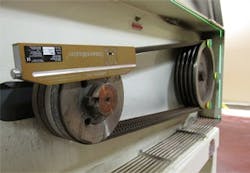Get your alignment in line: Don't jiggle while you work
Like a lot of reliability engineers, Joe Anderson, former reliability manager at the J.M. Smucker Co., appreciated – in theory – that precise pulley alignment is critical to preventing vibration problems and ensuring successful operations.
“My understanding was, ‘Yeah, we need to do it,’ ” Anderson says. “But you always have these excuses.”
When the Smucker’s plant at which Anderson worked launched a dedicated vibration monitoring and control program a year-and-a-half ago, though, Anderson quickly became a convert to making precision alignment a priority.
The plant purchased a vibration analyzer (VIBXPERT) and laser alignment tool (the SheaveMaster Greenline) from Ludeca to help aid in identifying machine defects that appeared to be linked to vibration caused by misalignment. Laser alignment allowed for correcting vertical angularity, horizontal angularity, and axial offset – the three types of misalignment – simultaneously. Whoever was using the laser alignment tool, then, could be sure that adjustments made to correct one alignment problem didn’t create an issue on another plane.
Plus, unlike with the old-school string method of alignment, laser alignment requires only one person to pinpoint misalignments and make corrections. “The beauty of the laser is it’s a visual; it’s precise; it’s one person, so it’s very quick,” says Ana Maria Delgado, certified reliability leader and marketing manager at Ludeca. Also, “You want to bring it as close as possible because every thousandth of an inch counts,” Delgado says. “The more precise the alignment, the better the performance of the machine.”
Results came fast. Laser alignment reduced time to align the facility’s blowers by 75%, Anderson says, equating to savings of nearly $4,200 a year. Moreover, the facility cut downtime and occurrences by almost 70% in the year after the vibration program was implemented, for a cost avoidance of nearly $63,000, according to Anderson.
“Me gaining that understanding (of the importance of precision alignment), that’s what drove the urgency to get these things fixed,” says Anderson, who now works as senior reliability manager at the Schwan Food Co.
Anderson is quick to point out that technology alone wasn’t responsible for the impressive returns that the vibration-monitoring initiative produced. Consistent training and a cultural shift to emphasize the importance of precise alignment on every piece of belt-driven equipment also played a vital role.
Working with Ludeca, Anderson and his team developed procedures for using the vibration analyzer and laser alignment tool. Then, “we trained in-house every maintenance person to understand that alignment’s critical when replacing assets,” he says. “Plus, we put in place that everything had to be aligned.”
Getting everyone on the 31-person maintenance team to come around to putting alignment best practices into practice took some time, Anderson acknowledges. “But as they started to see the failures go away, more and more people got engaged,” he says. “I had the select core that have always bought in (to reliability initiatives), and the quick wins were what got us buy-in from everybody.”
For facilities considering ramping up their vibration monitoring, Anderson says he’d first take a step back and focus on alignment – training technicians how to do proper alignments – and then checking alignment on all belt-driven equipment currently in use, especially on components that are critical.
Anderson offers several additional tips for establishing an alignment program:
- Go back after 48 to 72 hours of run time and check belt tension. Adjust as needed.
- Develop standard alignment procedures and train everyone who’s affected to this standard. Ideally, the training will feature visual instructions.
- Conduct annual or semiannual refresher training.
- Capture cost savings/avoidance to demonstrate the program’s value.
“If I’d had the knowledge then, I’d have started with alignment first,” Anderson says. Offers Delgado: “The whole point is we’re trying to eliminate the defects. If you properly align your machine, you already have a great start, because you’re going to be avoiding the misalignment, which is going to cause vibration, which is going to cause wear of the pulley and wear of the belts. By eliminating that defect, you’re already ahead of the game.”
Finally, “It’s more cost-effective than correcting vibration issues that have lingered, Anderson says, and “you have a quicker return on investment.” Plus, he adds, “It’s a lot easier than trying to teach someone vibration.”
[sidebar id="4"]


